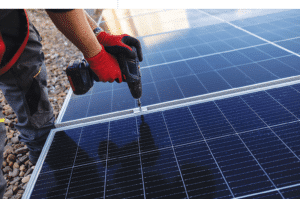
Affordable housing developers may have to maximize public incentives to ensure multifamily projects can complete financing packages under new energy codes being adopted by Massachusetts municipalities. iStock photo
While Massachusetts leaders simultaneously tackle the twin crises of climate change and housing affordability, it’s a burgeoning question of whether a solution for the former is mutually exclusive for the other.
Construction costs are already sky-high in Greater Boston, and there is fear decarbonization regulations can add even more strain on wallets when it comes to buying a house unless there are some kind of development incentive or subsidy offered.
A report last year by the Home Builders & Remodelers Association of Massachusetts noted the state’s specialized stretch energy code – which can be approved voluntarily by each community – is likely to increase the cost of home construction by as much as 3.8 percent, adding as much as $23,000 to the median single-family home.
That could put homeownership out of reach for as many as 33,000 families, per the report conducted by researchers at the MIT Center for Real Estate and Wentworth Institute of Technology.
But don’t take this as a signal the Home Builders & Remodelers Association is lashing out at sustainable building practices, either. The organization is bringing attention to how, in a costly building market like New England, there are additional initiatives that need to roll out to keep housing costs in check.
The report calls for implementing land use changes that pave the way for more density and multifamily housing, as this type of development is more energy efficient than a single-family home. Time is money – especially in Greater Boston’s lengthy planning and approvals process, so another option is streamlining this permitting phase for projects that meet or exceed a municipality’s opt-in specialized stretch code that requires new construction projects to have net-zero emissions.
The code, taking effect last July in 18 early-adopter communities, requires builders to include tight building envelopes, pre-wire for future electric heating systems and install solar arrays when feasible.
The report also recommends additional tax credits, financial incentives and technical assistance – as well as educating contractors and developers about new energy-efficient building practices and the available incentives to make them less cost-prohibitive.
Others in the region’s design and development community appear to agree.
“We see the scale of the crisis there and understand how attainable housing is core to our success as a society just as climate resiliency is,” said Catherine Rollins, director of the Urban Land Institute’s Boston chapter. “There’s so much momentum to really do something and make progress on both that I think the will is there, and I think the creativity can also be there.”

Contractors building to Passive House standards for the first time often charge a significant premium over experienced contractors. iStock photo
Climate Bank Gets Seed Money
Rollins pointed to last year’s launch of the Massachusetts Community Climate Bank, billed by the Healey administration as the first green bank in the U.S. dedicated to affordable housing projects. The initiative is seeded with $50 million and has a main objective to woo private and public funds under the federal Inflation Reduction Act and deploy those both on new construction of decarbonized buildings as well as building retrofits that comply with the state’s climate resiliency objectives.
Others point to the highly energy-efficient Passive House design as a path forward for affordable housing projects to pencil out financially and comply with decarbonization efforts, as the construction industry becomes more experienced with the technique. The Massachusetts Clean Energy Center conducted a Passive House Design Challenge to show new construction can be built to these energy efficient standards at a cost premium under 3 percent.
The Sponsors of Mass Save, a collaboration of utility and energy providers in the state, offer technical support and financial incentives for Passive House multifamily projects.
“That was really a result of dedicated advocacy from many of our community development organizations saying [they] want to do this but [they] need to have some financial support because of that incremental cost,” said Emily Jones, a senior program officer at Local Initiatives Support Corp. Boston. “This was really a response to that.”
The low-income housing tax credit, energy efficient home improvement credit and residential energy credit are other tools in the energy efficient building toolkit to help affordable projects make sense financially, Jones added.
Contractors Need Technical Help
The technical support is also key because the Home Builders & Remodelers Association report notes experienced contractors usually saw construction premiums go up between 2 and 4 percent on Passive House projects while first-time contractors saw premiums as high as 10 percent.
“We know how to build durable, efficient, and healthy buildings, and this is a time when incentives are available and the code supports it,” said Keihly Moore, an architect and sustainable design coordinator at Studio G Architects. “All the factors are coming together: funding, technology and regulations to support beyond the bare minimum because we know we can do better. Being smart with our resources and building more efficiently now helps us in the long term with cost, health and sustainability.”
While there is an expectation costs can come down the more developers and contractors gain experience with decarbonized building planning, there is also a need for open dialog about what does and doesn’t work.
“The inherent barrier in this is that you often don’t hear about projects that don’t make it to the public’s radar,” Rollins said. “Part of it is just a willingness to really share information and a willingness on the different advocates’ sides to listen to what the other is saying so that, once we have the facts on the table, we can figure out: Are there more incentives needed? Are there efficiencies of scale? How can you be creative around this to get this done?”




 |
| 

